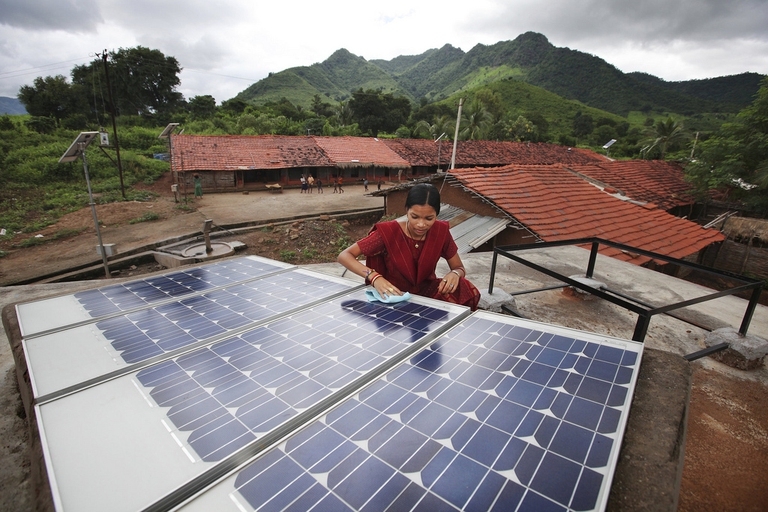
A group of experts in Tokyo suggested pouring radioactive water from Fukushima into the open sea. A marine biochemist explains the consequences of this absurd decision.
Entro pochi anni in India il 98 per cento delle stazioni ferroviarie saranno alimentate con solare fotovoltaico
98 per cent of India’s railway stations will be powered by solar energy. This is what the government of the Union of India aims to achieve by 2018 on 7,000 railway stations out of 7,137 across the country. The announcement was made by minister of Finance Arun Jaitley, who added that works have already started in 300 railway stations, with the number expected to increase to 2,000 soon.
Solar energy will be provided to Indian Railways thanks to the Solar Mission of the Indian Railways programme, which includes the installation of solar power systems on railway stations’ rooftops. The aim is reducing the dependence on fossil fuels of India’s railway system, which ranks first globally for the number of passengers in relations to the amount of miles.
Along with rooftop solar power systems, Indian Railways aims to launch large-scale solar projects, including ground-mounted capacity. Also, the companies that manufacture the energy systems will be able to purchase the energy produced directly from Indian Railways.
Indian Railways is the country’s first energy consumer. For this, it has been working for years to meet its energy demand with renewable sources. Indian Railways’ electricity consumption is estimated to exceed 2 per cent of the country’s total consumption, using 2.6 billion litres of diesel each year. This turns into an expense of 5 billion dollars every year, which is about one fourth of the railways’ total income. Of course, costs must be compared with passengers, which amount to up to 20 million people every year in one of the world’s most trafficked railway networks. Passengers are on the rise and so is cargo transport, which increased by 165.7 per cent between 1992 and 2015 mainly due to raw and processed materials.
In 2016 India signed a partnership with the United Nations Development Programme (UNDP) to set up 5 GW of solar power capacity through a mix of rooftop and ground-mounted projects. So far, Indian railways launched their solar energy development programme in two states, Gujarat and Rajasthan, where 25 MG of rooftop and 50 MG of ground-mounted capacity will be installed in the first phase of the programme. In the second phase, the programme will involve 9 other states with 60 MG of rooftop and 660 MG ground-mounted capacity. During the third phase, 400 MW rooftop and 3,800 MW ground-mounted capacity will be installed in rest of the country.
India’s government is investing in solar power in order to reduce its dependence on fossil fuels. Developing solar power in railways is a step in this direction and represents the right path towards a more sustainable development of the country.
Siamo anche su WhatsApp. Segui il canale ufficiale LifeGate per restare aggiornata, aggiornato sulle ultime notizie e sulle nostre attività.
![]()
Quest'opera è distribuita con Licenza Creative Commons Attribuzione - Non commerciale - Non opere derivate 4.0 Internazionale.
A group of experts in Tokyo suggested pouring radioactive water from Fukushima into the open sea. A marine biochemist explains the consequences of this absurd decision.
A federal court in Washington, D.C. has struck down the Dakota Access Pipeline, following years of campaigning by the Standing Rock Sioux tribe.
The Scottish island of Eigg is self-sufficient for its energy needs, relying almost entirely on renewable sources, especially thanks to a coordinated community effort.
President Magufuli in unmovable in going ahead with the Stiegler’s Gorge dam despite conservationists’ warnings of the damage it will cause the Selous Game Reserve’s ecosystem and wildlife.
A large dam along the Luangwa River in Zambia would have posed a serious risk to local people and wildlife, leading hundreds of thousands to oppose it. A call to which the government responded by halting plans to build it.
The first one megawatt solar power plant in the Chernobyl exclusion zone has become operational. This is the first step in a renewable energy development project promoted by the Ukrainian government in the area.
A tanker exploded at a gas and petrol station in Nigeria’s Nasarawa state on the 10th of September, killing 35 people and leaving some burned beyond recognition; 3 citizens had several spine and brain injuries, 2 of them are still on Intesive Care Units. Fela Habila , a local singer, is now stable and out of danger but
The largest tidal power plant in the world will be built in the Larantuka Straits. It will serve 100,000 people and help overcome some of the challenges of energy provision in Indonesia.
Robben Island’s solar energy micro-grid project will produce almost one million kilowatt hours of electricity annually, significantly reducing the cost and impact of buying diesel.








